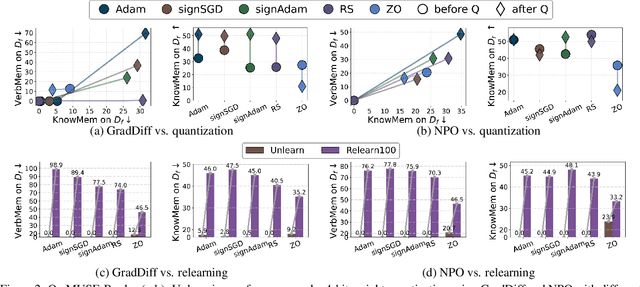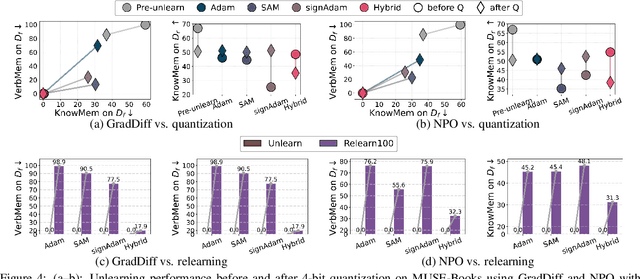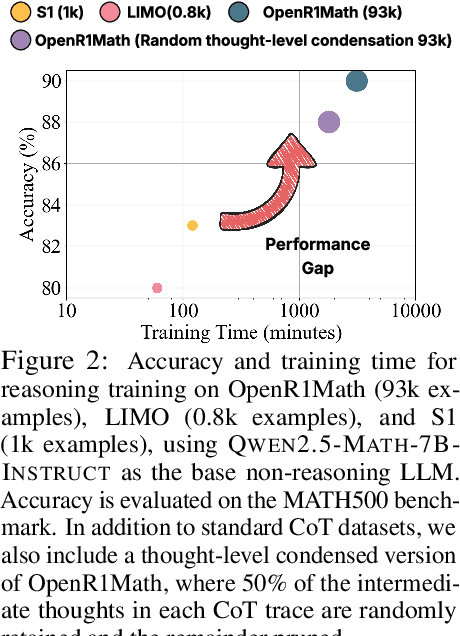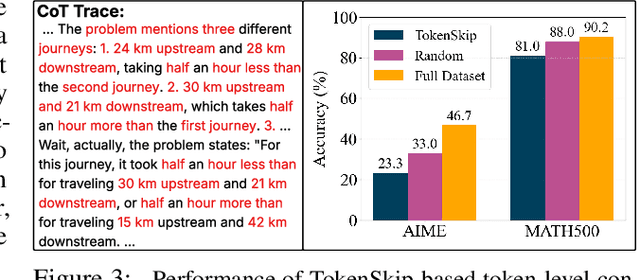Sijia Liu
N3C Natural Language Processing
Downgrade to Upgrade: Optimizer Simplification Enhances Robustness in LLM Unlearning
Oct 02, 2025



Abstract:Large language model (LLM) unlearning aims to surgically remove the influence of undesired data or knowledge from an existing model while preserving its utility on unrelated tasks. This paradigm has shown promise in addressing privacy and safety concerns. However, recent findings reveal that unlearning effects are often fragile: post-unlearning manipulations such as weight quantization or fine-tuning can quickly neutralize the intended forgetting. Prior efforts to improve robustness primarily reformulate unlearning objectives by explicitly assuming the role of vulnerability sources. In this work, we take a different perspective by investigating the role of the optimizer, independent of unlearning objectives and formulations, in shaping unlearning robustness. We show that the 'grade' of the optimizer, defined by the level of information it exploits, ranging from zeroth-order (gradient-free) to first-order (gradient-based) to second-order (Hessian-based), is tightly linked to the resilience of unlearning. Surprisingly, we find that downgrading the optimizer, such as using zeroth-order methods or compressed-gradient variants (e.g., gradient sign-based optimizers), often leads to stronger robustness. While these optimizers produce noisier and less precise updates, they encourage convergence to harder-to-disturb basins in the loss landscape, thereby resisting post-training perturbations. By connecting zeroth-order methods with randomized smoothing, we further highlight their natural advantage for robust unlearning. Motivated by these insights, we propose a hybrid optimizer that combines first-order and zeroth-order updates, preserving unlearning efficacy while enhancing robustness. Extensive experiments on the MUSE and WMDP benchmarks, across multiple LLM unlearning algorithms, validate that our approach achieves more resilient forgetting without sacrificing unlearning quality.
Reasoning Model Unlearning: Forgetting Traces, Not Just Answers, While Preserving Reasoning Skills
Jun 15, 2025Abstract:Recent advances in large reasoning models (LRMs) have enabled strong chain-of-thought (CoT) generation through test-time computation. While these multi-step reasoning capabilities represent a major milestone in language model performance, they also introduce new safety risks. In this work, we present the first systematic study to revisit the problem of machine unlearning in the context of LRMs. Machine unlearning refers to the process of removing the influence of sensitive, harmful, or undesired data or knowledge from a trained model without full retraining. We show that conventional unlearning algorithms, originally designed for non-reasoning models, are inadequate for LRMs. In particular, even when final answers are successfully erased, sensitive information often persists within the intermediate reasoning steps, i.e., CoT trajectories. To address this challenge, we extend conventional unlearning and propose Reasoning-aware Representation Misdirection for Unlearning ($R^2MU$), a novel method that effectively suppresses sensitive reasoning traces and prevents the generation of associated final answers, while preserving the model's reasoning ability. Our experiments demonstrate that $R^2MU$ significantly reduces sensitive information leakage within reasoning traces and achieves strong performance across both safety and reasoning benchmarks, evaluated on state-of-the-art models such as DeepSeek-R1-Distill-LLaMA-8B and DeepSeek-R1-Distill-Qwen-14B.
BLUR: A Bi-Level Optimization Approach for LLM Unlearning
Jun 09, 2025Abstract:Enabling large language models (LLMs) to unlearn knowledge and capabilities acquired during training has proven vital for ensuring compliance with data regulations and promoting ethical practices in generative AI. Although there are growing interests in developing various unlearning algorithms, it remains unclear how to best formulate the unlearning problem. The most popular formulation uses a weighted sum of forget and retain loss, but it often leads to performance degradation due to the inherent trade-off between forget and retain losses. In this work, we argue that it is important to model the hierarchical structure of the unlearning problem, where the forget problem (which \textit{unlearns} certain knowledge and/or capabilities) takes priority over the retain problem (which preserves model utility). This hierarchical structure naturally leads to a bi-level optimization formulation where the lower-level objective focuses on minimizing the forget loss, while the upper-level objective aims to maintain the model's utility. Based on this new formulation, we propose a novel algorithm, termed Bi-Level UnleaRning (\texttt{BLUR}), which not only possesses strong theoretical guarantees but more importantly, delivers superior performance. In particular, our extensive experiments demonstrate that \texttt{BLUR} consistently outperforms all the state-of-the-art algorithms across various unlearning tasks, models, and metrics. Codes are available at https://github.com/OptimAI-Lab/BLURLLMUnlearning.
EPiC: Towards Lossless Speedup for Reasoning Training through Edge-Preserving CoT Condensation
Jun 04, 2025



Abstract:Large language models (LLMs) have shown remarkable reasoning capabilities when trained with chain-of-thought (CoT) supervision. However, the long and verbose CoT traces, especially those distilled from large reasoning models (LRMs) such as DeepSeek-R1, significantly increase training costs during the distillation process, where a non-reasoning base model is taught to replicate the reasoning behavior of an LRM. In this work, we study the problem of CoT condensation for resource-efficient reasoning training, aimed at pruning intermediate reasoning steps (i.e., thoughts) in CoT traces, enabling supervised model training on length-reduced CoT data while preserving both answer accuracy and the model's ability to generate coherent reasoning. Our rationale is that CoT traces typically follow a three-stage structure: problem understanding, exploration, and solution convergence. Through empirical analysis, we find that retaining the structure of the reasoning trace, especially the early stage of problem understanding (rich in reflective cues) and the final stage of solution convergence, is sufficient to achieve lossless reasoning supervision. To this end, we propose an Edge-Preserving Condensation method, EPiC, which selectively retains only the initial and final segments of each CoT trace while discarding the middle portion. This design draws an analogy to preserving the "edge" of a reasoning trajectory, capturing both the initial problem framing and the final answer synthesis, to maintain logical continuity. Experiments across multiple model families (Qwen and LLaMA) and benchmarks show that EPiC reduces training time by over 34% while achieving lossless reasoning accuracy on MATH500, comparable to full CoT supervision. To the best of our knowledge, this is the first study to explore thought-level CoT condensation for efficient reasoning model distillation.
The Dual Power of Interpretable Token Embeddings: Jailbreaking Attacks and Defenses for Diffusion Model Unlearning
Apr 30, 2025Abstract:Despite the remarkable generalization capabilities of diffusion models, recent studies have shown that these models can memorize and generate harmful content when prompted with specific text instructions. Although fine-tuning approaches have been developed to mitigate this issue by unlearning harmful concepts, these methods can be easily circumvented through jailbreaking attacks. This indicates that the harmful concept has not been fully erased from the model. However, existing attack methods, while effective, lack interpretability regarding why unlearned models still retain the concept, thereby hindering the development of defense strategies. In this work, we address these limitations by proposing an attack method that learns an orthogonal set of interpretable attack token embeddings. The attack token embeddings can be decomposed into human-interpretable textual elements, revealing that unlearned models still retain the target concept through implicit textual components. Furthermore, these attack token embeddings are robust and transferable across text prompts, initial noises, and unlearned models. Finally, leveraging this diverse set of embeddings, we design a defense method applicable to both our proposed attack and existing attack methods. Experimental results demonstrate the effectiveness of both our attack and defense strategies.
LLM Unlearning Reveals a Stronger-Than-Expected Coreset Effect in Current Benchmarks
Apr 16, 2025Abstract:Large language model unlearning has become a critical challenge in ensuring safety and controlled model behavior by removing undesired data-model influences from the pretrained model while preserving general utility. Significant recent efforts have been dedicated to developing LLM unlearning benchmarks such as WMDP (Weapons of Mass Destruction Proxy) and MUSE (Machine Unlearning Six-way Evaluation), facilitating standardized unlearning performance assessment and method comparison. Despite their usefulness, we uncover for the first time a novel coreset effect within these benchmarks. Specifically, we find that LLM unlearning achieved with the original (full) forget set can be effectively maintained using a significantly smaller subset (functioning as a "coreset"), e.g., as little as 5% of the forget set, even when selected at random. This suggests that LLM unlearning in these benchmarks can be performed surprisingly easily, even in an extremely low-data regime. We demonstrate that this coreset effect remains strong, regardless of the LLM unlearning method used, such as NPO (Negative Preference Optimization) and RMU (Representation Misdirection Unlearning), the popular ones in these benchmarks. The surprisingly strong coreset effect is also robust across various data selection methods, ranging from random selection to more sophisticated heuristic approaches. We explain the coreset effect in LLM unlearning through a keyword-based perspective, showing that keywords extracted from the forget set alone contribute significantly to unlearning effectiveness and indicating that current unlearning is driven by a compact set of high-impact tokens rather than the entire dataset. We further justify the faithfulness of coreset-unlearned models along additional dimensions, such as mode connectivity and robustness to jailbreaking attacks. Codes are available at https://github.com/OPTML-Group/MU-Coreset.
When is Task Vector Provably Effective for Model Editing? A Generalization Analysis of Nonlinear Transformers
Apr 15, 2025Abstract:Task arithmetic refers to editing the pre-trained model by adding a weighted sum of task vectors, each of which is the weight update from the pre-trained model to fine-tuned models for certain tasks. This approach recently gained attention as a computationally efficient inference method for model editing, e.g., multi-task learning, forgetting, and out-of-domain generalization capabilities. However, the theoretical understanding of why task vectors can execute various conceptual operations remains limited, due to the highly non-convexity of training Transformer-based models. To the best of our knowledge, this paper provides the first theoretical characterization of the generalization guarantees of task vector methods on nonlinear Transformers. We consider a conceptual learning setting, where each task is a binary classification problem based on a discriminative pattern. We theoretically prove the effectiveness of task addition in simultaneously learning a set of irrelevant or aligned tasks, as well as the success of task negation in unlearning one task from irrelevant or contradictory tasks. Moreover, we prove the proper selection of linear coefficients for task arithmetic to achieve guaranteed generalization to out-of-domain tasks. All of our theoretical results hold for both dense-weight parameters and their low-rank approximations. Although established in a conceptual setting, our theoretical findings were validated on a practical machine unlearning task using the large language model Phi-1.5 (1.3B).
Safety Mirage: How Spurious Correlations Undermine VLM Safety Fine-tuning
Mar 14, 2025Abstract:Recent vision-language models (VLMs) have made remarkable strides in generative modeling with multimodal inputs, particularly text and images. However, their susceptibility to generating harmful content when exposed to unsafe queries raises critical safety concerns. While current alignment strategies primarily rely on supervised safety fine-tuning with curated datasets, we identify a fundamental limitation we call the "safety mirage" where supervised fine-tuning inadvertently reinforces spurious correlations between superficial textual patterns and safety responses, rather than fostering deep, intrinsic mitigation of harm. We show that these spurious correlations leave fine-tuned VLMs vulnerable even to a simple one-word modification-based attack, where substituting a single word in text queries with a spurious correlation-inducing alternative can effectively bypass safeguards. Additionally, these correlations contribute to the over prudence, causing fine-tuned VLMs to refuse benign queries unnecessarily. To address this issue, we show machine unlearning (MU) as a powerful alternative to supervised safety fine-tuning as it avoids biased feature-label mappings and directly removes harmful knowledge from VLMs while preserving their general capabilities. Extensive evaluations across safety benchmarks show that under one-word attacks, MU-based alignment reduces the attack success rate by up to 60.17% and cuts unnecessary rejections by over 84.20%. Codes are available at https://github.com/OPTML-Group/VLM-Safety-MU. WARNING: There exist AI generations that may be offensive in nature.
Scalable Back-Propagation-Free Training of Optical Physics-Informed Neural Networks
Feb 17, 2025Abstract:Physics-informed neural networks (PINNs) have shown promise in solving partial differential equations (PDEs), with growing interest in their energy-efficient, real-time training on edge devices. Photonic computing offers a potential solution to achieve this goal because of its ultra-high operation speed. However, the lack of photonic memory and the large device sizes prevent training real-size PINNs on photonic chips. This paper proposes a completely back-propagation-free (BP-free) and highly salable framework for training real-size PINNs on silicon photonic platforms. Our approach involves three key innovations: (1) a sparse-grid Stein derivative estimator to avoid the BP in the loss evaluation of a PINN, (2) a dimension-reduced zeroth-order optimization via tensor-train decomposition to achieve better scalability and convergence in BP-free training, and (3) a scalable on-chip photonic PINN training accelerator design using photonic tensor cores. We validate our numerical methods on both low- and high-dimensional PDE benchmarks. Through circuit simulation based on real device parameters, we further demonstrate the significant performance benefit (e.g., real-time training, huge chip area reduction) of our photonic accelerator.
Towards LLM Unlearning Resilient to Relearning Attacks: A Sharpness-Aware Minimization Perspective and Beyond
Feb 07, 2025Abstract:The LLM unlearning technique has recently been introduced to comply with data regulations and address the safety and ethical concerns of LLMs by removing the undesired data-model influence. However, state-of-the-art unlearning methods face a critical vulnerability: they are susceptible to ``relearning'' the removed information from a small number of forget data points, known as relearning attacks. In this paper, we systematically investigate how to make unlearned models robust against such attacks. For the first time, we establish a connection between robust unlearning and sharpness-aware minimization (SAM) through a unified robust optimization framework, in an analogy to adversarial training designed to defend against adversarial attacks. Our analysis for SAM reveals that smoothness optimization plays a pivotal role in mitigating relearning attacks. Thus, we further explore diverse smoothing strategies to enhance unlearning robustness. Extensive experiments on benchmark datasets, including WMDP and MUSE, demonstrate that SAM and other smoothness optimization approaches consistently improve the resistance of LLM unlearning to relearning attacks. Notably, smoothness-enhanced unlearning also helps defend against (input-level) jailbreaking attacks, broadening our proposal's impact in robustifying LLM unlearning. Codes are available at https://github.com/OPTML-Group/Unlearn-Smooth.
 Add to Chrome
Add to Chrome Add to Firefox
Add to Firefox Add to Edge
Add to Edge